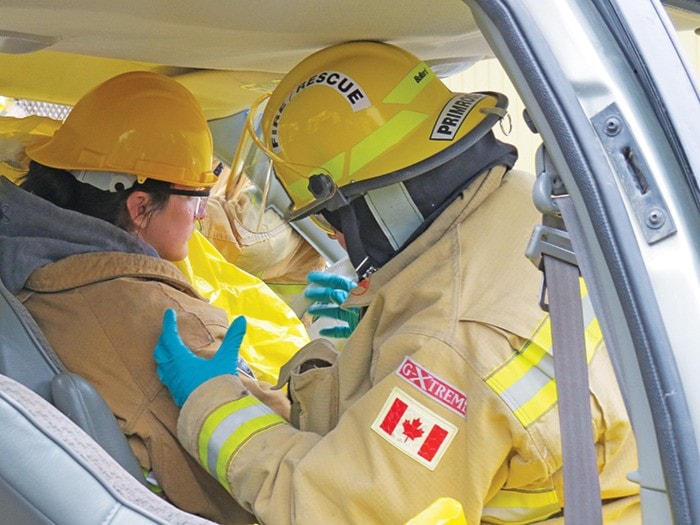Safety and teamwork were the focus Sunday, Oct. 20 when Ladysmith Fire/Rescue hosted a tri-service training session.
About 20 firefighters, 13 B.C. Ambulance Service members and six RCMP members took part in the training session, where they spent the afternoon practicing auto extrication.
“What it’s doing is we have new firefighters, and the Ambulance Service has a lot of new people, and auto extrication is something they don’t do,” explained fire chief Ray Delcourt. “We’re trying to show them we have the tools to make it safer to get patients out of the vehicle. The three agencies who respond [to a collision], we have to have a team built so that we all work together and are all on the same page.”
Delcourt says Ladysmith Fire/Rescue has a lot of experienced auto extrication instructors at the fire hall who have a lot of knowledge to share.
“We need to know how to do it, get it done quickly enough and get that patient out of the vehicle,” he said.
The training was also helpful to go over the responders’ safety on the highway, noted Delcourt.
Steve Van Der Minne, unit chief for B.C. Ambulance Service Station 159 in Ladysmith, says a training session like this is very helpful.
“It helps from our point of view when dealing with patients to anticipate what the firefighters are going to do,” he said. “It helps to know the fire department’s capability in getting patients out. It also makes us more aware of safety considerations when we’re at an accident scene.”
With major trauma like a highway collision, time is of the essence, emphasized Van Der Minne.
“They used to talk about the ‘golden hour,’ and now the [International Trauma Life Support] course paramedics do emphasized you might not have an hour,” he said. “That’s why the fire department practises how to get people safely and quickly out. Our focus is doing critical treatments and getting patents to the appropriate hospital. Doing that requires all three [services]. We’re trying to minimize the scene time to give the hospital as much time as possible; that’s why it’s important we know what we’re doing at the scene. The shorter we keep the scene time getting someone out safely, the more time surgeons at the hospital can have to save the patient.”
For the RCMP, Const. Tim Cosgrove says this training session was a chance to see what the procedures are for the fire department and for the paramedics and see how police officers can help.
“At an accident scene, our first priority is safety, including the first responders,” he said. “We want to know how we can best serve them as they’re dealing with cars and people. We want to know what they need from us, and they want to know what we need from them.”
Like Delcourt and Van Der Minne, Cosgrove feels it’s very important for the firefighters, paramedics and police officers to work together and know each other’s roles.
“It’s good to know what they’re doing,” he said of the auto extrication training. “It’s a good way to see what they do in a safe setting.”
Cosgrove says we’re lucky in Ladysmith that the fire department is so quick to get to the scene of a collision.
“Often, they do get to the scene before us, but it’s also good to know what they need from us if we get there first,” he said. “With the ambulance, if we get on scene before them, it’s good to know what they need.”
Delcourt says they are hoping to do a tri-service training session like this annually.
